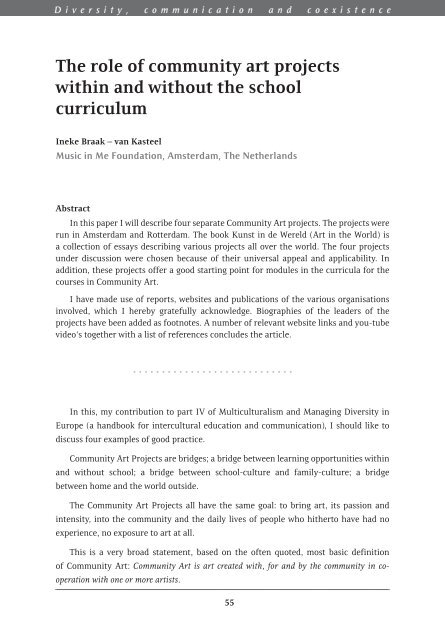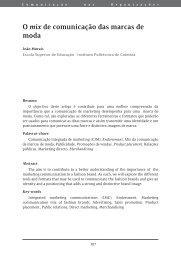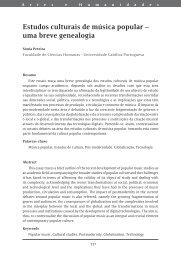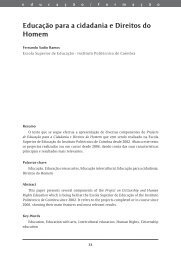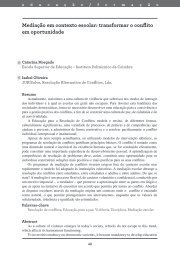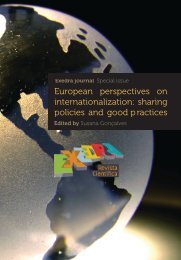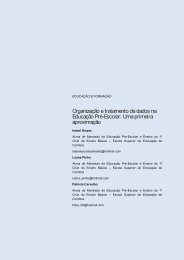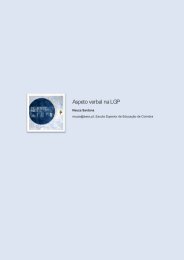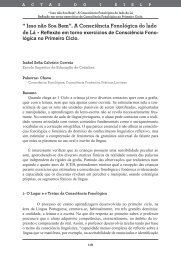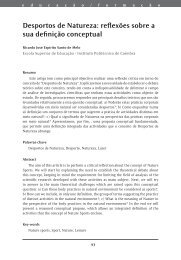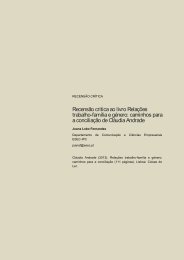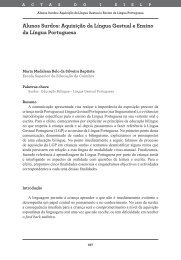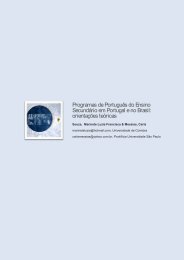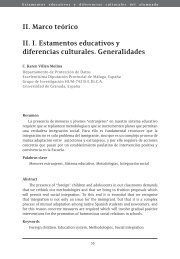The role of community art projects within and without the ... - Exedra
The role of community art projects within and without the ... - Exedra
The role of community art projects within and without the ... - Exedra
- No tags were found...
You also want an ePaper? Increase the reach of your titles
YUMPU automatically turns print PDFs into web optimized ePapers that Google loves.
Diversity, communication <strong>and</strong> coexistence<strong>The</strong> <strong>role</strong> <strong>of</strong> <strong>community</strong> <strong>art</strong> <strong>projects</strong><strong>within</strong> <strong>and</strong> <strong>without</strong> <strong>the</strong> schoolcurriculumIneke Braak – van KasteelMusic in Me Foundation, Amsterdam, <strong>The</strong> Ne<strong>the</strong>rl<strong>and</strong>sAbstractIn this paper I will describe four separate Community Art <strong>projects</strong>. <strong>The</strong> <strong>projects</strong> wererun in Amsterdam <strong>and</strong> Rotterdam. <strong>The</strong> book Kunst in de Wereld (Art in <strong>the</strong> World) isa collection <strong>of</strong> essays describing various <strong>projects</strong> all over <strong>the</strong> world. <strong>The</strong> four <strong>projects</strong>under discussion were chosen because <strong>of</strong> <strong>the</strong>ir universal appeal <strong>and</strong> applicability. Inaddition, <strong>the</strong>se <strong>projects</strong> <strong>of</strong>fer a good st<strong>art</strong>ing point for modules in <strong>the</strong> curricula for <strong>the</strong>courses in Community Art.I have made use <strong>of</strong> reports, websites <strong>and</strong> publications <strong>of</strong> <strong>the</strong> various organisationsinvolved, which I hereby gratefully acknowledge. Biographies <strong>of</strong> <strong>the</strong> leaders <strong>of</strong> <strong>the</strong><strong>projects</strong> have been added as footnotes. A number <strong>of</strong> relevant website links <strong>and</strong> you-tubevideo’s toge<strong>the</strong>r with a list <strong>of</strong> references concludes <strong>the</strong> <strong>art</strong>icle.In this, my contribution to p<strong>art</strong> IV <strong>of</strong> Multiculturalism <strong>and</strong> Managing Diversity inEurope (a h<strong>and</strong>book for intercultural education <strong>and</strong> communication), I should like todiscuss four examples <strong>of</strong> good practice.Community Art Projects are bridges; a bridge between learning opportunities <strong>within</strong><strong>and</strong> <strong>without</strong> school; a bridge between school-culture <strong>and</strong> family-culture; a bridgebetween home <strong>and</strong> <strong>the</strong> world outside.<strong>The</strong> Community Art Projects all have <strong>the</strong> same goal: to bring <strong>art</strong>, its passion <strong>and</strong>intensity, into <strong>the</strong> <strong>community</strong> <strong>and</strong> <strong>the</strong> daily lives <strong>of</strong> people who hi<strong>the</strong>rto have had noexperience, no exposure to <strong>art</strong> at all.This is a very broad statement, based on <strong>the</strong> <strong>of</strong>ten quoted, most basic definition<strong>of</strong> Community Art: Community Art is <strong>art</strong> created with, for <strong>and</strong> by <strong>the</strong> <strong>community</strong> in cooperationwith one or more <strong>art</strong>ists.55
exedra • special issue • 2011All Community Artists have in common that <strong>the</strong>ir <strong>art</strong> is created, born <strong>and</strong> developed<strong>within</strong> a <strong>community</strong> where people are created, born <strong>and</strong> growing up in conditions <strong>of</strong> stressbecause <strong>of</strong> intercultural differences, poor grassroots communication <strong>and</strong> increasingintolerance (Europe). Community Artists <strong>and</strong> <strong>the</strong>ir <strong>art</strong> promote social cohesion – whichis why <strong>the</strong>se <strong>art</strong>ists are so exceptional.<strong>The</strong>re are places in <strong>the</strong> world, like Iraq, Afghanistan <strong>and</strong> <strong>the</strong> Palestinian communitiesin <strong>the</strong> Middle East, where political decisions <strong>and</strong> religious differences – which may ormay not have <strong>the</strong>ir roots in history – have so polarised <strong>the</strong> population that <strong>the</strong>re areserious security issues, large groups living in abject poverty <strong>and</strong> many people who haveno opportunity to live independent <strong>and</strong> fulfilling lives. In <strong>the</strong>se areas, Community Artshould not be just a stimulus for social cohesion, but should also initiate <strong>and</strong> createopportunities, such as jobs in <strong>the</strong> cultural sector with possible spin-<strong>of</strong>fs to o<strong>the</strong>r areas.In <strong>the</strong> developing countries in Africa we find extreme poverty, poor public health,<strong>of</strong>ten <strong>the</strong> threat <strong>of</strong> war or war-like violence <strong>and</strong> large groups <strong>of</strong> displaced persons <strong>and</strong>refugees. We see evidence that Community Art Projects help <strong>the</strong>se people to get a gripon <strong>the</strong>ir lives again. <strong>The</strong> same applies to <strong>the</strong> favelas in Latin America where <strong>the</strong> childrenlive in permanent danger due to <strong>the</strong> prevalence <strong>of</strong> poverty <strong>and</strong> crime. A characteristic <strong>of</strong>Community Art Projects is that <strong>the</strong>y are all tailor-made to accommodate <strong>the</strong> culture <strong>and</strong>circumstance <strong>of</strong> each individual location.I have chosen <strong>the</strong>se p<strong>art</strong>icular <strong>projects</strong> because each <strong>of</strong> <strong>the</strong>se can be used as ablueprint for <strong>projects</strong> outside <strong>The</strong> Ne<strong>the</strong>rl<strong>and</strong>s, because <strong>the</strong> p<strong>art</strong>icipating CommunityArtists occupy a special <strong>and</strong> p<strong>art</strong>icular position <strong>within</strong> <strong>the</strong> Community Art organisationin this country <strong>and</strong> also because all four <strong>projects</strong> were developed in close co-operationwith educators.“H<strong>and</strong> in H<strong>and</strong>” <strong>and</strong> “Kunst in de Wereld” (Art in <strong>the</strong> World) were both <strong>the</strong> result <strong>of</strong><strong>projects</strong> by <strong>the</strong> Community Arts divisions <strong>of</strong> <strong>the</strong> Cod<strong>art</strong>s Conservatoire <strong>of</strong> <strong>the</strong> RotterdamUniversity for <strong>the</strong> Arts, <strong>and</strong> <strong>the</strong> ArtEz University <strong>of</strong> <strong>the</strong> Arts in Arnhem, Enschede <strong>and</strong>Zwolle.“Jij en je Wijk” (You <strong>and</strong> your qu<strong>art</strong>er) was developed by IJsterk – a <strong>community</strong>welfare project <strong>of</strong> <strong>the</strong> city <strong>of</strong> Amsterdam toge<strong>the</strong>r with <strong>the</strong> Education Faculty <strong>of</strong> <strong>the</strong>Amsterdam branch <strong>of</strong> University InHoll<strong>and</strong>.“Jalan Jalan” resulted in extensive publications. <strong>The</strong> project was carried out by ACCU,a <strong>community</strong> <strong>art</strong>s foundation toge<strong>the</strong>r with Kunstenaars en Co. (<strong>art</strong>ists & co) in cooperationwith <strong>the</strong> Dep<strong>art</strong>ment <strong>of</strong> Citizenship <strong>and</strong> Cultural Dynamics at <strong>the</strong> Hogeschoolvan Amsterdam (University <strong>of</strong> Applied Sciences).An o<strong>the</strong>r similarity between de <strong>projects</strong> is that each was integrated into an academic56
Ineke Braak – van Kasteel • <strong>The</strong> <strong>role</strong> <strong>of</strong> <strong>community</strong> <strong>art</strong> <strong>projects</strong> <strong>within</strong> <strong>and</strong> <strong>without</strong> <strong>the</strong> school curriculum<strong>The</strong> 2009 <strong>the</strong>me for Jalan Jalan was “Zeeburgers”, literally “burghers <strong>of</strong> <strong>the</strong> sea”but also “inhabitants <strong>of</strong> Zeeburg”. All sorts <strong>of</strong> “sea-things”, from sharks to mermaids,submarines to octopuses, were depicted with fantasy <strong>and</strong> imagination. Through this<strong>the</strong>me, <strong>the</strong> power <strong>and</strong> beauty was shown <strong>of</strong> all those different people from all thosedifferent cultures who live <strong>and</strong> work in <strong>the</strong> same qu<strong>art</strong>er.<strong>The</strong> Indonesian word Jalan Jalan means: walking through <strong>the</strong> streets.On September 12th, 2009, an Iftar was organised in <strong>the</strong> East-India qu<strong>art</strong>er. <strong>The</strong> Iftaris <strong>the</strong> meal eaten by observing Muslims after sundown during <strong>the</strong> month <strong>of</strong> Ramadan.<strong>The</strong> fast is broken according to tradition <strong>and</strong> <strong>the</strong>n <strong>the</strong> meal follows. How <strong>the</strong> Iftar isorganised <strong>and</strong> what is eaten depends very much on <strong>the</strong> p<strong>art</strong>icular Muslim culture. InIndonesia <strong>the</strong> Iftar is announced by <strong>the</strong> sound <strong>of</strong> <strong>the</strong> beduk drum, in Pakistan <strong>the</strong>re arespecial Iftar bells. <strong>The</strong> meal is eaten with family <strong>and</strong> friends <strong>and</strong> generally lasts a longtime as it is unwise to eat too quickly on an empty stomach.<strong>The</strong>refore, <strong>the</strong> procession Jalan Jalan is <strong>the</strong> sign to break <strong>the</strong> ramadan fast, <strong>the</strong>nfollows <strong>the</strong> <strong>community</strong> Iftar. <strong>The</strong> Iftar, which is free, is prepared by people in <strong>the</strong><strong>community</strong> belonging to a variety <strong>of</strong> Muslim cultures. <strong>The</strong>re is an open air stage wherea program is presented by local amateur <strong>and</strong> pr<strong>of</strong>essional <strong>art</strong>ists <strong>and</strong> by <strong>community</strong>groups <strong>of</strong> all ages, colours <strong>and</strong> activities. Of prime importance is <strong>the</strong> year-long programto prepare for <strong>the</strong> Jalan Jalan festival through activities in schools, <strong>community</strong> centres,cultural centres <strong>and</strong> clubs. An example is <strong>the</strong> Pearl d’Amour, an playground opera forprimary school pupils.59
exedra • special issue • 2011<strong>The</strong> co-ordination for Jalan Jalan is done by <strong>the</strong> ACCU Foundation, its <strong>art</strong>isticmanager Jos Z<strong>and</strong>vliet <strong>and</strong> business manager Septimia Kuhlmann 1 .<strong>The</strong> o<strong>the</strong>r Amsterdam project is “Jij en je Wijk” (you <strong>and</strong> your qu<strong>art</strong>er).This project enables teachers, school <strong>and</strong> <strong>community</strong> workers to engage pupilsdirectly with <strong>the</strong> environment in which <strong>the</strong>y live. <strong>The</strong> project is designed for 11 – 14 yearolds <strong>and</strong> aims to stimulate, challenge <strong>and</strong> involve. It encourages children to consider<strong>the</strong>ir world seriously <strong>and</strong> responsibly, to talk about it <strong>and</strong> to encourage a dialogue at atime in <strong>the</strong>ir lives when <strong>the</strong>y learn to be more independent.<strong>The</strong> pervasive <strong>the</strong>me <strong>of</strong> <strong>the</strong> project You <strong>and</strong> your Qu<strong>art</strong>er is citizenship. Learningabout citizenship provides <strong>the</strong> basic knowledge, aptitude <strong>and</strong> attitude necessary to playan active <strong>role</strong> in society. <strong>The</strong> mission <strong>of</strong> <strong>the</strong> project is to give practical form <strong>and</strong> contentto <strong>the</strong> ra<strong>the</strong>r abstract notion <strong>of</strong> citizenship. <strong>The</strong> young p<strong>art</strong>icipants get <strong>of</strong>fered <strong>the</strong> means60
Ineke Braak – van Kasteel • <strong>The</strong> <strong>role</strong> <strong>of</strong> <strong>community</strong> <strong>art</strong> <strong>projects</strong> <strong>within</strong> <strong>and</strong> <strong>without</strong> <strong>the</strong> school curriculum<strong>and</strong> <strong>the</strong> opportunities to research, express <strong>and</strong> communicate what citizenship means to<strong>the</strong>m <strong>and</strong> to <strong>the</strong>ir neighbourhood.Having chosen a subject, <strong>the</strong> group takes p<strong>art</strong> in a workshop Journalism, Writing <strong>and</strong>Photography. With <strong>the</strong>ir Press card <strong>the</strong>y <strong>the</strong>n each go out into <strong>the</strong>ir qu<strong>art</strong>er <strong>and</strong> write<strong>the</strong>ir <strong>art</strong>icle. After that <strong>the</strong>y post <strong>the</strong>se, toge<strong>the</strong>r with <strong>the</strong> photographs <strong>the</strong>y took, on <strong>the</strong>project website. An interesting requirement is that <strong>the</strong> <strong>art</strong>icles must be linked to GoogleMaps.Also, <strong>the</strong>re are links with free door-to-door newspapers. This means that<strong>the</strong> <strong>community</strong> does not just read about itself but also learns something about<strong>the</strong> views <strong>of</strong> <strong>the</strong> youngsters. A dialogue ensues <strong>and</strong> streng<strong>the</strong>ns <strong>the</strong> socialcohesion in <strong>the</strong> qu<strong>art</strong>er. <strong>The</strong> mission <strong>of</strong> You <strong>and</strong> your Qu<strong>art</strong>er is as follows:• Get to know o<strong>the</strong>r people <strong>and</strong> your qu<strong>art</strong>er; visit places where teenagers would normallynever go.• Acquire journalistic skills; learn to work on a website <strong>and</strong> with Google Maps.• Bring <strong>the</strong> <strong>community</strong> into <strong>the</strong> school <strong>and</strong> vice versa: improve social cohesion in <strong>the</strong><strong>community</strong>• Acquire citizenship skills in <strong>the</strong> areas <strong>of</strong> democracy, p<strong>art</strong>icipation <strong>and</strong> identity.• Teach co-operation by allowing teenagers to p<strong>art</strong>icipate in <strong>the</strong> <strong>community</strong>; improve <strong>the</strong>teenage self-confidence <strong>and</strong> sense <strong>of</strong> pride.61
exedra • special issue • 2011<strong>The</strong> project You <strong>and</strong> your Qu<strong>art</strong>er was developed by <strong>the</strong> unit “Community <strong>and</strong> School”<strong>of</strong> <strong>the</strong> social services division IJsterk, <strong>the</strong> municipality <strong>of</strong> Amsterdam in conjunctionwith Jeroen Bottema 2 <strong>of</strong> <strong>the</strong> School <strong>of</strong> Education <strong>of</strong> InHoll<strong>and</strong> Unversity <strong>and</strong> with WaagSociety, a foundation for research into creative technology for social innovation.“H<strong>and</strong> in H<strong>and</strong>”, <strong>the</strong> third neighbourhood Community Art project is located in <strong>the</strong>south <strong>of</strong> Rotterdam in <strong>the</strong> target areas Oud Zuid en Vreewijk. <strong>The</strong>se areas overlap twoadjoining Rotterdam boroughs, Charlois <strong>and</strong> Feijenoord. <strong>The</strong> target area Vreewijk isentirely p<strong>art</strong> <strong>of</strong> Feijenoord, while Oud Zuid comprises seven qu<strong>art</strong>ers <strong>of</strong> which threeare p<strong>art</strong> <strong>of</strong> Charlois (Tarwewijk, Oud Charlois <strong>and</strong> Carnisse) <strong>and</strong> four are p<strong>art</strong> <strong>of</strong>Feijenoord (Afrika<strong>and</strong>erwijk, Bloemh<strong>of</strong>, Hillesluis <strong>and</strong> Katendrecht).62
Ineke Braak – van Kasteel • <strong>The</strong> <strong>role</strong> <strong>of</strong> <strong>community</strong> <strong>art</strong> <strong>projects</strong> <strong>within</strong> <strong>and</strong> <strong>without</strong> <strong>the</strong> school curriculumTraditionally, <strong>the</strong> area was inhabited by dockworkers. Most <strong>of</strong> <strong>the</strong> homes are small,cheap, badly insulated pre-war rental houses. Bloemh<strong>of</strong>, Tarwewijk <strong>and</strong> Hillesluistoge<strong>the</strong>r have 35,700 inhabitants. In <strong>the</strong> first two qu<strong>art</strong>ers <strong>the</strong> <strong>of</strong>ten multi-storey homesare packed closely toge<strong>the</strong>r <strong>and</strong> <strong>the</strong>re is little greenery.Out <strong>of</strong> all <strong>the</strong> inhabitants <strong>of</strong> Feijenoord, <strong>the</strong> people <strong>of</strong> Bloemh<strong>of</strong> are least contentwith <strong>the</strong>ir qu<strong>art</strong>er <strong>and</strong> complain most about insecurity. <strong>The</strong> current inhabitants <strong>of</strong> <strong>the</strong>setarget areas are generally young, unemployed, not highly educated <strong>and</strong> with low earningpotential. Many live on benefit. <strong>The</strong>re are, in general, no decent houses to be foundin <strong>the</strong>se areas that could be bought by people with a higher income. <strong>The</strong>se <strong>the</strong>reforeusually move away, also because <strong>of</strong> <strong>the</strong> poor shopping <strong>and</strong> o<strong>the</strong>r facilities in <strong>the</strong> areas.This has put fur<strong>the</strong>r pressure on small businesses with <strong>the</strong> resulting boarding up <strong>of</strong>shops <strong>and</strong> v<strong>and</strong>alism.<strong>The</strong> south <strong>of</strong> Rotterdam is easily accessibly both by car <strong>and</strong> public transport. It alsohas a good supply <strong>of</strong> business premises at relatively low rents. <strong>The</strong>re are some importantattractions, such as Ahoy (conferences <strong>and</strong> events), Zuidplein (shopping mall), <strong>the</strong>Feyenoord football stadium, Now & Wow (p<strong>art</strong>y centre), Kop van Zuid (urban renewalproject) <strong>and</strong>, since late 2007, <strong>the</strong> ss Rotterdam. All <strong>of</strong> <strong>the</strong>se attract many visitors <strong>and</strong>publicity, generate cash flow <strong>and</strong> improve <strong>the</strong> image <strong>and</strong> attractiveness <strong>of</strong> <strong>the</strong> south <strong>of</strong><strong>the</strong> city.Vreewijk has 7000 homes <strong>of</strong> which 80% belong to housing corporations. Most homesare old single family dwellings <strong>and</strong> three qu<strong>art</strong>ers was built before WWII. More than14,000 people live in <strong>the</strong> area. About 70% are <strong>of</strong> Dutch descent. This is far above <strong>the</strong>Rotterdam average <strong>of</strong> 54%.People from Surinam (formerly Dutch Guyana) form a relatively large proportion <strong>of</strong><strong>the</strong> immigrant population. As to age distribution, <strong>the</strong> group 23 – 39 year olds is heavilyunder represented. <strong>The</strong>re is, however, an exceptionally large proportion <strong>of</strong> seniors. In<strong>the</strong> age group 65 <strong>and</strong> over, 90% <strong>of</strong> <strong>the</strong> population is <strong>of</strong> Dutch descent.In 2008 <strong>the</strong> qu<strong>art</strong>er <strong>of</strong> Feyenoord – <strong>and</strong> its footballclub – celebrated its firstcentennial.63
exedra • special issue • 2011To celebrate this centennial, Peter van den Hurk 3 , leader <strong>of</strong> <strong>the</strong> Rotterdam Wijk<strong>the</strong>aterdevised a plan to create a show about <strong>the</strong> ups <strong>and</strong> downs <strong>of</strong> this legendary, world-famousfootball club <strong>and</strong> its faithful supporters. To produce <strong>the</strong> show he got toge<strong>the</strong>r with <strong>the</strong>conservatoire <strong>and</strong> dance academy <strong>of</strong> Cod<strong>art</strong>s University for <strong>the</strong> Arts, <strong>the</strong> InternationalCommunity Arts Festival <strong>and</strong> <strong>The</strong>atre Zuidplein.<strong>The</strong> football club plays an important p<strong>art</strong> in <strong>the</strong> lives <strong>of</strong> many families. Each match iseagerly awaited. Emotions run high: exuberant joy when <strong>the</strong> club wins <strong>and</strong> black sorrowwhen it loses. But, whatever happens, <strong>the</strong> Legion, as <strong>the</strong> supporters are called, alwaysst<strong>and</strong> behind <strong>the</strong>ir club. In good times <strong>and</strong> bad. <strong>The</strong>ir bedrock is <strong>the</strong> supporters’ song“H<strong>and</strong> in h<strong>and</strong>, kameraden” (join h<strong>and</strong>s, mates). <strong>The</strong> context is formed by life in <strong>the</strong>qu<strong>art</strong>er.64
Ineke Braak – van Kasteel • <strong>The</strong> <strong>role</strong> <strong>of</strong> <strong>community</strong> <strong>art</strong> <strong>projects</strong> <strong>within</strong> <strong>and</strong> <strong>without</strong> <strong>the</strong> school curriculum<strong>The</strong> shows are produced in close co-operation with <strong>the</strong> actors, who are all local.Helped by pr<strong>of</strong>essional writers <strong>and</strong> stage directors, <strong>the</strong> local people show <strong>the</strong>ir ownexperiences in <strong>the</strong> performances. <strong>The</strong> result was <strong>the</strong> soaring Community Art production“H<strong>and</strong> in H<strong>and</strong>”. A show full <strong>of</strong> music, dance <strong>and</strong> <strong>the</strong>atre. <strong>The</strong>re were ten performances<strong>of</strong> <strong>the</strong> show in <strong>the</strong> Zuidplein <strong>The</strong>atre, <strong>the</strong> home <strong>of</strong> <strong>the</strong> Rotterdam Wijk<strong>the</strong>ater company(RWT)<strong>The</strong> Rotterdams Wijk<strong>the</strong>ater (Rotterdam Community-based <strong>The</strong>atre) is a <strong>the</strong>atrecompany that, supported by Rotterdam City Council, produces <strong>the</strong>atre for <strong>and</strong> by peoplefrom <strong>the</strong> <strong>community</strong>. <strong>The</strong> main aim <strong>of</strong> this <strong>community</strong> <strong>art</strong>s organisation is to developnew writing, accessible, appealing <strong>and</strong> relevant to people who do not normally go to <strong>the</strong><strong>the</strong>atre. In order to invite new <strong>and</strong> culturally excluded audiences <strong>the</strong>y present <strong>the</strong>atreperformances that are based on <strong>the</strong> stories <strong>of</strong> <strong>the</strong>ir own <strong>community</strong>, <strong>and</strong> <strong>the</strong>reforedealing with issues that are relevant to those groups. By <strong>the</strong> sheer amount <strong>of</strong> newwork <strong>the</strong>y develop, <strong>the</strong> more than 60, usually packed, shows that are performed in <strong>the</strong>various <strong>community</strong> centres <strong>and</strong> <strong>the</strong> string <strong>of</strong> new <strong>projects</strong> in <strong>the</strong> pipeline, <strong>The</strong> RotterdamWijk<strong>the</strong>ater is living pro<strong>of</strong> that <strong>the</strong>atre by <strong>and</strong> for local people can be relevant, interesting,moving <strong>and</strong> entertaining.Some characteristics: RWT does not present <strong>the</strong> <strong>community</strong> with an existing play,but develops plays based on stories <strong>and</strong> events told <strong>the</strong>m by <strong>the</strong> local people.All actors are drawn from <strong>the</strong> <strong>community</strong> - <strong>the</strong> people <strong>of</strong> RWT only facilitate, coach,direct, <strong>and</strong> provide technical back-up <strong>and</strong> assistance.RWT works primarily in disadvantaged neighbourhoods with people who have littleor no experience <strong>of</strong> <strong>the</strong>atre, ei<strong>the</strong>r as performers or audience.<strong>The</strong> plays tend not to focus on big issues like ‘teenage pregnancy’ or ‘child abuse’but ra<strong>the</strong>r reflect life in <strong>the</strong> neighbourhood, with all <strong>the</strong> laughter <strong>and</strong> sorrow that thatentails. Depending on <strong>the</strong> ages <strong>within</strong> <strong>and</strong> <strong>the</strong> cultural diversity <strong>of</strong> <strong>the</strong> group <strong>the</strong>y workwith, o<strong>the</strong>r disciplines such as dance, music or video may be incorporated.<strong>The</strong> Rotterdams Wijk<strong>the</strong>ater is working on establishing an international network<strong>of</strong> people or <strong>the</strong>atre groups with a similar approach. <strong>The</strong>y are specifically looking forinitiatives that not necessarily have <strong>the</strong>atre as <strong>the</strong>ir primary medium but have a similarmethodology i.e. not <strong>the</strong> “distribution <strong>of</strong> <strong>the</strong> high <strong>art</strong>s” to <strong>the</strong> communities nor <strong>the</strong> sociodramamethods popular in <strong>the</strong> 1960’s <strong>and</strong> 70’s.<strong>The</strong> Rotterdams Wijk<strong>the</strong>ater is funded by a small group <strong>of</strong> pr<strong>of</strong>essional writers <strong>and</strong>directors. <strong>The</strong>y register experiences from improvisations by local people <strong>and</strong> transform<strong>the</strong>se stories into a stage-play to be performed by people from <strong>the</strong> <strong>community</strong>. <strong>The</strong>‘actors’ come up with universal <strong>the</strong>mes like fear, loneliness, drugs, <strong>the</strong> increase <strong>of</strong>65
exedra • special issue • 2011violence, newcomers in <strong>the</strong> <strong>community</strong>, parent <strong>and</strong> child, upbringing <strong>and</strong> education,discrimination <strong>and</strong> racism, tolerance <strong>and</strong> toge<strong>the</strong>rness which, through improvisation,produces material for <strong>the</strong> script.<strong>The</strong> RWT has no regular company <strong>of</strong> actors. For each performance <strong>the</strong> cast is formedby non-pr<strong>of</strong>essional actors from <strong>the</strong> neighbourhood where <strong>the</strong> play is based, written<strong>and</strong> rehearsed. <strong>The</strong> local people joining <strong>the</strong> production usually have no connection with<strong>the</strong>atre whatsoever <strong>and</strong> usually have never been on stage before. This means that a lot<strong>of</strong> work <strong>and</strong> effort is required for a long <strong>and</strong> very intense production process, whichconsists <strong>of</strong> two important phases. <strong>The</strong> pre-production phase consists <strong>of</strong> improvisation<strong>and</strong> discussion, which is such an important source <strong>of</strong> material reflecting life in <strong>the</strong><strong>community</strong>. It is this material that forms <strong>the</strong> body <strong>of</strong> <strong>the</strong> script. <strong>The</strong> production phaseconsists <strong>of</strong> <strong>the</strong> rehearsals <strong>and</strong> <strong>the</strong> technical production <strong>of</strong> <strong>the</strong> play. In both phases <strong>the</strong>actors from <strong>the</strong> <strong>community</strong> are <strong>the</strong> engine driving <strong>the</strong> process. <strong>The</strong>y are an irreplaceablesource <strong>of</strong> inspiration.RWT does most <strong>of</strong> its work <strong>within</strong> <strong>the</strong> communities <strong>the</strong>y address. Rehearsals <strong>and</strong>performances are held outside <strong>the</strong> main stream Rotterdam <strong>the</strong>atre world. Instead <strong>the</strong>setake place in <strong>community</strong> <strong>art</strong>s centres, <strong>community</strong> centers, youth clubs <strong>and</strong> schools. In<strong>the</strong>ir small van RWT goes all over Rotterdam, more <strong>of</strong>ten than not having to move pooltables <strong>and</strong> pinball machines to rig up a working <strong>the</strong>atre with lights, follow-spots <strong>and</strong>slide projectors, perhaps a dance floor, black-out curtains, <strong>and</strong> improvised dressingrooms. <strong>The</strong> Rotterdams Wijk<strong>the</strong>ater has worked in <strong>the</strong> different boroughs <strong>of</strong> Rotterdamsince 1992.<strong>The</strong> last project in conjunction with a university is <strong>the</strong> book Kunst in de Wereld (Artin <strong>the</strong> World) by Merlijn Twaalfhoven. 4In his book, this composer <strong>and</strong> <strong>the</strong>atre maker proposes that <strong>art</strong> should be shown66
Ineke Braak – van Kasteel • <strong>The</strong> <strong>role</strong> <strong>of</strong> <strong>community</strong> <strong>art</strong> <strong>projects</strong> <strong>within</strong> <strong>and</strong> <strong>without</strong> <strong>the</strong> school curriculumoutside <strong>the</strong> <strong>the</strong>atre <strong>and</strong> <strong>without</strong> a pedestal. He maintains that <strong>art</strong> could have a muchlarger impact when taken outside <strong>the</strong> usual boundaries: into <strong>the</strong> countryside, into towns,amongst people. Art, in o<strong>the</strong>r words, that anybody can encounter anywhere: CommunityArt.<strong>The</strong> first chapter deals with how to look at things, how to consider <strong>art</strong> in its space,<strong>art</strong> in its context <strong>and</strong> <strong>the</strong> sensory impact that <strong>art</strong> can give. All <strong>of</strong> this is richly illustratedwith many colour photographs. <strong>The</strong> content <strong>of</strong> this chapter would fit very nicely into atextbook on ‘how to look at <strong>art</strong>’.<strong>The</strong> o<strong>the</strong>r essays in <strong>the</strong> book give many practical tips to young <strong>art</strong>ists, <strong>the</strong>atre makers<strong>and</strong> musicians. Where to create something? How to present your ideas? Co-operationwith o<strong>the</strong>r p<strong>art</strong>icipants, rehearsals, etcetera. <strong>The</strong>re is also an appendix with a list <strong>of</strong>useful websites. It is a very practical book with tips generated by all sorts <strong>of</strong> <strong>community</strong><strong>art</strong>s <strong>projects</strong> but principally reflecting his own experiences. It does not want to give amethod or instructions, it is a prop (or a prod) for all people who make <strong>art</strong> <strong>and</strong> who liketo think <strong>and</strong> reflect. It is <strong>the</strong>refore aimed at all people who, like Merlijn, feel that <strong>art</strong> ismore than entertainment for <strong>the</strong> serious <strong>and</strong> <strong>the</strong> solemn, <strong>and</strong> at <strong>the</strong> growing group <strong>of</strong><strong>art</strong>ists convinced that a concert hall, <strong>the</strong>atre or gallery is not always <strong>the</strong> place best suitedto create an extraordinary experience.Merlijn himself literally creates Art in <strong>the</strong> World – ap<strong>art</strong> from his <strong>projects</strong> in <strong>the</strong>Ne<strong>the</strong>rl<strong>and</strong>s, he worked in Central Europe, Cyprus <strong>and</strong>, especially lately, in <strong>the</strong> MiddleEast.One <strong>of</strong> his <strong>projects</strong>, “Symphony for All” (2008), was an orchestra with musicians aged67
exedra • special issue • 2011between ten <strong>and</strong> fifty who came from Jordan, Palestine, <strong>The</strong> Ne<strong>the</strong>rl<strong>and</strong>s, Sweden, Italy,Egypt <strong>and</strong> Germany <strong>and</strong> performed in <strong>the</strong> King Hussein Cultural Centre in <strong>the</strong> Jordaniancapital city <strong>of</strong> Amman. <strong>The</strong> music was composed by Merlijn Twaalfhoven, <strong>and</strong> includedexisting Arab songs but also melodies resulting from intensive collaboration between <strong>the</strong>composer <strong>and</strong> Arab musicians <strong>and</strong> singers during <strong>the</strong> compositional process. Refugeechildren, who had never played in a concert before, were given preparatory workshops<strong>and</strong> so played a substantial p<strong>art</strong> in <strong>the</strong> actual performance. <strong>The</strong> audience was extremelymoved <strong>and</strong> reacted very enthusiastically. After <strong>the</strong> show, Merlijn received many positivereactions from <strong>the</strong> musicians, children <strong>and</strong> audience alike. This experience is beingincorporated into new initiatives <strong>and</strong> future <strong>projects</strong>, intended to continue creatingmusic <strong>projects</strong> that bring contrasting cultures toge<strong>the</strong>r.Merlijn Twaalfhoven’s latest project in <strong>the</strong> Al Quds Underground Festival Jerusalem.It is a festival that takes place in <strong>the</strong> evening in sitting rooms <strong>and</strong> secret locations inEast-Jerusalem. In 2009 <strong>the</strong> UN organisation UNESCO has declared Jerusalem ascultural capital <strong>of</strong> <strong>the</strong> Arab world. However, in East-Jerusalem this is barely noticeable.<strong>The</strong> Israeli police have forbidden or cancelled all cultural activities. <strong>The</strong>re is moreinformation on <strong>the</strong> website.And <strong>the</strong>n finally He<strong>art</strong>beat Senegal, <strong>the</strong> “dream” project <strong>of</strong> three students at <strong>the</strong>conservatoire, Ryanne van Sabben, Fleur Kamphuijs en Chris Mul 5 . Although this is notreally a <strong>community</strong> <strong>art</strong>s project <strong>the</strong> students did, in preparation, contribute to a project<strong>of</strong> Merlijn Twaalfhoven <strong>and</strong> took p<strong>art</strong> in workshops given by Jos Z<strong>and</strong>vliet. <strong>The</strong> emphasis<strong>of</strong> <strong>the</strong>ir study project was on cultural entrepreneurship in <strong>the</strong> context <strong>of</strong> <strong>the</strong>ir futurepr<strong>of</strong>ession as music teacher <strong>within</strong> <strong>and</strong> <strong>without</strong> <strong>the</strong> education system. <strong>The</strong> course was68
Ineke Braak – van Kasteel • <strong>The</strong> <strong>role</strong> <strong>of</strong> <strong>community</strong> <strong>art</strong> <strong>projects</strong> <strong>within</strong> <strong>and</strong> <strong>without</strong> <strong>the</strong> school curriculumgeared towards <strong>the</strong> pupils <strong>of</strong> <strong>the</strong> school <strong>and</strong> not towards involving <strong>the</strong> <strong>community</strong>.How did it happen?At <strong>the</strong> end <strong>of</strong> <strong>the</strong>ir first year, <strong>the</strong> students were asked to write down <strong>the</strong>ir dream. Bytotal co-incidence, it turned out that three students had <strong>the</strong> same dream. <strong>The</strong>y teamedup, integrated <strong>the</strong>ir dreams <strong>and</strong> st<strong>art</strong>ed to explore possibilities. At that time <strong>the</strong>y couldnot fathom that, two years hence, <strong>the</strong>y would have established a Foundation <strong>and</strong> wouldbe <strong>of</strong>f to Senegal for <strong>the</strong> second time to teach music at <strong>the</strong>ir very own “school <strong>of</strong> culture”.But that is what happened. <strong>The</strong>y raised funds to build <strong>the</strong>ir school. What <strong>the</strong>y wantedto do was to make musicians out <strong>of</strong> street children <strong>and</strong> “on <strong>the</strong> side” also teach <strong>the</strong>msome reading <strong>and</strong> writing. One year later <strong>the</strong> school had been built <strong>and</strong> thirty childrenhad registered. <strong>The</strong> first week <strong>the</strong> students were <strong>the</strong>re <strong>the</strong>y opened <strong>the</strong> school, taught<strong>the</strong> children <strong>and</strong> trained teachers who would keep <strong>the</strong> school going. After <strong>the</strong>ir return toHoll<strong>and</strong> <strong>the</strong>y stayed in touch regularly.69
exedra • special issue • 2011<strong>The</strong> next school year <strong>the</strong>y did more fundraising <strong>and</strong> established a second school.Money was also collected to pay for instruments <strong>and</strong> furniture. Our students were nowin <strong>the</strong>ir third year <strong>and</strong> <strong>the</strong>y took second year students with <strong>the</strong>m to Senegal to let <strong>the</strong>mshare in <strong>the</strong>ir dream. While in Holl<strong>and</strong>, <strong>the</strong> students prepare courses in music, dance<strong>and</strong> drama. Most <strong>of</strong> <strong>the</strong> time, African instruments are used, but <strong>the</strong> 4 – 18 year oldSenegalese pupils are also introduced to western instruments.In 2009 <strong>the</strong> third <strong>and</strong> fourth culture school was established. Number five will followin 2010.Finally.As explained in <strong>the</strong> introduction, <strong>the</strong> experiences <strong>of</strong> all <strong>projects</strong> described shouldprove extremely useful in <strong>the</strong> development <strong>of</strong> curricula for Community Arts courses;curricula that will not only focus on <strong>art</strong>istic development <strong>and</strong> entrepreneurship, but70
Ineke Braak – van Kasteel • <strong>The</strong> <strong>role</strong> <strong>of</strong> <strong>community</strong> <strong>art</strong> <strong>projects</strong> <strong>within</strong> <strong>and</strong> <strong>without</strong> <strong>the</strong> school curriculumplace major emphasis on developing social, political, economic <strong>and</strong> communicationsskills. A curriculum “Community Arts” will have to be developed from <strong>the</strong> performanceproductions <strong>and</strong> follow a set <strong>of</strong> generally applicable criteria, <strong>the</strong> most important alwaysbeing that each project should be “with, for <strong>and</strong> by <strong>the</strong> members <strong>of</strong> <strong>the</strong> local <strong>community</strong>,in <strong>the</strong>ir own environment”.Websites <strong>and</strong> linksHet oranjefonds: (http://www.oranjefonds.nl)Lektoraten Community Art: Community Art at Cod<strong>art</strong>s, Rotterdam (http://www.cod<strong>art</strong>s.nl)PopKunst, ArtEZ, Institute <strong>of</strong> <strong>the</strong> Arts, Arnhem, Enschede en Zwolle (http://www.<strong>art</strong>ez.nl)Community Art Projects:Jalan Jalan: http://www.jalan-jalan.nlJalan Jalan - Stichting ACCU: http://www.stichtingaccu.nlJalan Jalan: http://www.youtube.com/bekijkACCU#p/aJalan Jalan – Parel d’Amour, a playground opera for primary schools: http://www.youtube.com/watch?v=GS4mvP6xWhYJalan Jalan - Jos Z<strong>and</strong>vliet: http://www.josz<strong>and</strong>vliet.nl/tekst onder.htmlJos Z<strong>and</strong>vliet: http://vredevanutrecht.com/<strong>community</strong>-<strong>art</strong>/2007/02/07/teatro-pasmi/Jalan Jalan – Kunstenaars & Co: http://www.kunstenaarsenco.nlJij en je Wijk: http://www.googlede<strong>art</strong>h-blog.nl/category/maatschappijleer/Jij en je Wijk: http://www.jijenjewijk.nlJij en je Wijk – IJsterk: http://www.ajp.ijsterk.nl/film.php?item=106Jij en je Wijk – InHoll<strong>and</strong>: http://www.inholl<strong>and</strong>.nlJij en je Wijk – Waag Society: http://www.waag.org/project/jijenjewijkH<strong>and</strong> in H<strong>and</strong> – Rotterdams wijk<strong>the</strong>ater: http://www.rotterdamswijk<strong>the</strong>ater.nl/voorstelling/h<strong>and</strong>_in_h<strong>and</strong>/18H<strong>and</strong> in H<strong>and</strong> – <strong>the</strong> st<strong>art</strong>: http://www.rotterdamswijk<strong>the</strong>ater.nl/pagina/video/6H<strong>and</strong> in H<strong>and</strong> – dancer aged 80: http://www.youtube.com/watch?v=3UnjdfNys8&feature=channelH<strong>and</strong> in H<strong>and</strong> – on <strong>the</strong> news: http://www.youtube.com/watch?v=wZGUu5siwc4&feature=channel71
exedra • special issue • 2011Spint – 110 jaar Feyenoord: http://www.youtube.com/watch?v=TDRD_gVUtDEKunst in de Wereld – Merlijn Twaalfhoven: http://www.musicforgaza.net/Music-for-Gaza/nl-NL/summary+in+english.aspxKunst in de Wereld – Merlijn Twaalfhoven: http://www.youtube.com/watch?v=c6sGLwcjL2oKunst in de wereld – PopArt: http://Awww.popkunst.nl/pages_EN/home.phpMerlijn Twaalfhoven – A strange composer: http://www.youtube.com/watch?v=rANsKLSGPNM&feature=relatedMerlijn Twaalfhoven - Megafonie by Merlijn Twaalfhoven- composition for 200p<strong>art</strong>icipantshttp://www.youtube.com/watch?v=KmcryY8g5xE&NR=1Merlijn Twaalfhoven - Carried by <strong>the</strong> Wind (Palestinian West Bank music doco)http://www.youtube.com/watch?v=008p-_LePrgMerlijn Twaalfhoven – Symphonie for all in Amman -http://www.youtube.com/watch?v=-WN4hnEuzscMerlijn Twaalfhoven – Symphony Arabica - http://www.arabica.nu/Merlijn Twaalfhoven – Al Quds Underground-festival in Jeruzalem - http://www.alqudsunderground.net/2009/10/welcome-to-al-quds-underground.htmlMerlijn Twaalfhoven - Composing <strong>the</strong> audience - http://www.youtube.com/watch?v=sso66ykkr-4&videos=z2wxG4T69wM&playnext_from=TL&playnext=1Stichting He<strong>art</strong>beat - http://www.stichting-he<strong>art</strong>beat.nlStichting He<strong>art</strong>beat - http://www.stichting-he<strong>art</strong>beat.nl/foto%27Stichting-He<strong>art</strong>beat.htmStichting He<strong>art</strong>beat – benefit concert 2007: http://www.youtube.com/watch?v=msv8WexHf-g&feature=player_embedded#ReferencesBottema, J. (2007). Jij en je Wijk. Amsterdam: Project Dep<strong>art</strong>ment <strong>of</strong> Education,University InHoll<strong>and</strong>, section Man <strong>and</strong> Society.Brouwer, P. (2008). Effectiveness Jalan Jalan. Research report. Ho<strong>of</strong>ddorp: TNO Kwaliteitvan Leven.Burghoorn, A. (2009). Twaalfhoven legt verborgen cultuur bloot in Jeruzalem [Twaalfhovenuncovers hidden culture in Jerusalem], Volkskrant.Erven, E. & den Hurk, P. (2006). Community Arts – Kunst en Kunde: report <strong>and</strong> reflections on72
Ineke Braak – van Kasteel • <strong>The</strong> <strong>role</strong> <strong>of</strong> <strong>community</strong> <strong>art</strong> <strong>projects</strong> <strong>within</strong> <strong>and</strong> <strong>without</strong> <strong>the</strong> school curriculuma meeting <strong>of</strong> experts. Rotterdam: Lectoraat Community Arts, Cod<strong>art</strong>s, Hogeschoolvoor de Kunsten.Jalan Jalan (2008). Artists <strong>and</strong> neighbours working toward a better <strong>community</strong>. Amsterdam:Kunstenaars & Co.Veenen, A. & Hurk, P. (2008). Geen mooier woord dan Feyenoord (no word more beautifulthan Feijenoord)– Case study <strong>of</strong> <strong>community</strong> <strong>art</strong> production “H<strong>and</strong> in H<strong>and</strong>”.Rotterdam: Hogeschool voor de Kunsten, Lectoraat Community Arts, Cod<strong>art</strong>s.Vroonh<strong>of</strong> , A. (2008). He<strong>art</strong>Beat. Journal for Art <strong>and</strong> Culture in Education, 7(12), 32-34.Kamphuijs, F., Mull, C. & Sabben, R. (2007). Projectplan 2007 Foundation He<strong>art</strong>Beat.Alkmaar, Hol.: Conservatoire University.Trienekens, S. J. (2009). Art at <strong>the</strong> he<strong>art</strong> <strong>of</strong> society – about citizenship <strong>and</strong> cultural dynamics.Amsterdam: University <strong>of</strong> Applied Sciences, Chair Active Citizenship.Twaalfhoven, M. (2009). Kunst in de Wereld. Chair PopKunst. Arnhem: ArtEZ Press.Notes1 Jos Z<strong>and</strong>vliet – Always <strong>the</strong> driving force, uniquely creative, <strong>art</strong>istic jack-<strong>of</strong>-all-trades,inexhaustible <strong>and</strong> always enthusiastic. He worked with <strong>the</strong> Dogtroep <strong>the</strong>atre company for 30 yearsas an actor, visual <strong>art</strong>ist, musician, composer, scriptwriter, <strong>art</strong>istic director <strong>and</strong> inspirer. Jos is one<strong>of</strong> <strong>the</strong> founders <strong>of</strong> ACCU.Septimia Kuhlmann – effortlessly combines <strong>art</strong>istic, organisational <strong>and</strong> commercial skills, reachesfor <strong>the</strong> sky but firmly grounded. She worked with Dogtroep for 15 years as an actor, originator<strong>of</strong> concepts for performances <strong>and</strong> acts, as a visual <strong>art</strong>ist <strong>and</strong> musician <strong>and</strong> location manager forcountless productions. Septimia is one <strong>of</strong> <strong>the</strong> founders <strong>of</strong> ACCU.2 Jeroen Bottema is a teacher trainer <strong>and</strong> researcher at <strong>the</strong> Centre <strong>of</strong> eLearning <strong>of</strong>InHoll<strong>and</strong> University <strong>of</strong> Applied Science, Amsterdam. He is also <strong>the</strong> founder <strong>of</strong> Bodie EducatiefOntwerp, a consultancy in ICT & innovation for education where he promoted ICT integration ineducation. He is <strong>the</strong> author <strong>of</strong> : Geld verdienen op Marktplaats en eBay (2005) (making money onMarktplaats <strong>and</strong> eBay), a publication in <strong>the</strong> series Computer Idea.3 Peter van den Hurk (1945) graduated in 1970 from <strong>the</strong> <strong>The</strong>atre School Maastricht. He<strong>the</strong>n worked as a director for, amongst o<strong>the</strong>rs, La Mama <strong>The</strong>atre in New York <strong>and</strong> <strong>the</strong> Groot LimburgToneel in Maastricht. In 1972 he as one <strong>of</strong> <strong>the</strong> founders <strong>of</strong> GL2, a <strong>the</strong>atre company that wantedto reach a new public. From 1980 to 1992 he taught at <strong>the</strong> Arnhem Academy <strong>of</strong> Art. From herehe initiated my <strong>community</strong> based <strong>projects</strong>. In 1992 he was one <strong>of</strong> <strong>the</strong> founders <strong>of</strong> <strong>the</strong> RotterdamsWijk<strong>the</strong>ater (RWT), a group that has become internationally known for its innovating <strong>the</strong>atre<strong>projects</strong> in working class areas in Rotterdam. From 2001 he also organizes bi-annual international<strong>community</strong> <strong>the</strong>atre festivals. <strong>The</strong>se are <strong>the</strong> basis for various books on <strong>community</strong> <strong>the</strong>atre that heedited. In 2005 he was appointed to <strong>the</strong> chair for Community Art at Cod<strong>art</strong>s University for <strong>the</strong>Arts in Rotterdam. He also still works as <strong>the</strong> <strong>art</strong>istic director <strong>of</strong> RWT. His credo is that a good<strong>community</strong> <strong>art</strong>ist is someone who cannot just produce at an <strong>art</strong>istically high level, but who canalso make this work accessible to people who do not, as a matter <strong>of</strong> course, have an interest in <strong>the</strong><strong>art</strong>s. One <strong>of</strong> <strong>the</strong> goals <strong>of</strong> Van den Hurk’s pr<strong>of</strong>essorship is to establish courses in <strong>community</strong> <strong>art</strong>s<strong>and</strong> eventually a curriculum for a course leading to a MA in Community Arts. Van den Hurk coauthoreda h<strong>and</strong>book <strong>of</strong> improvisation <strong>the</strong>atre: “Dramatiseren - van idee tot voorstelling” (creatingdrama – from idea to performance).4 Merlijn Twaalfhoven (Wapserveen, 14th February 1976) is a Dutch composer who is73
exedra • special issue • 2011also active in <strong>the</strong> organisation <strong>of</strong> multi-disciplinary music events. His compositions have beenperformed internationally by <strong>the</strong> Tokyo Symphony Orchestra, <strong>the</strong> Nederl<strong>and</strong>s PhilharmonischOrkest, <strong>the</strong> Royal Symphony Orchestra <strong>of</strong> Fl<strong>and</strong>ers, <strong>the</strong> Orchestra della Svizzera Italiana <strong>and</strong> manyo<strong>the</strong>rs. He is also involved with musicforgaza.net.From 2005 – 2008 Merlijn taught at <strong>the</strong> ArtEZ Institute for <strong>the</strong> Arts. His research projectPopKunst (PopArt) investigated how to bring <strong>the</strong> broader public into contact with contemporary<strong>art</strong> <strong>without</strong> making any concessions to <strong>art</strong>istic quality <strong>and</strong> integrity. Merlijn studied at <strong>the</strong>Conservatoire <strong>of</strong> Amsterdam, both <strong>the</strong> Viola as well as Composition with a p<strong>art</strong>icular interest inethno-musicology <strong>and</strong> contemporary music with sou<strong>the</strong>rn Indian techniques. His graduationproject was an inter-active essay on Japanese es<strong>the</strong>tics entitled “De Veelte” (muchness).5 Ryanne van Sabben, Fleur Kamphuijs <strong>and</strong> Chris Mul were students at <strong>the</strong> conservatoire<strong>of</strong> InHoll<strong>and</strong> university from September 2005 to July 2009, when <strong>the</strong>y graduated as music teachers.Ryanne now works at a secondary school <strong>and</strong> also teaches <strong>the</strong> flute. Fleur works at <strong>the</strong> Centre forArt <strong>and</strong> Culture „Cool“. <strong>The</strong> centre contains a <strong>the</strong>atre <strong>and</strong> also gives courses in music <strong>and</strong> musicals,drama <strong>and</strong> <strong>the</strong> visual <strong>art</strong>s. It also develops multi-disciplinary <strong>projects</strong> that are performed at schools.Chris works in education <strong>and</strong> also has her own company „De Zingende Serveersters“ (<strong>the</strong> singingwaitresses). Five pr<strong>of</strong>essional singers waitresses at receptions, business p<strong>art</strong>ies or festivals <strong>and</strong>perform <strong>the</strong>ir <strong>art</strong> in between <strong>the</strong> courses <strong>of</strong> <strong>the</strong> menu. For all <strong>of</strong> <strong>the</strong>m, He<strong>art</strong>beat remains <strong>the</strong>irpassion.74


